Building efficiency is more closely tied to equity than is commonly understood. Inefficient buildings produce high energy bills and contribute to energy burden that disproportionately falls on communities of color. A new report from the City Energy Project (CEP), a joint national initiative of IMT and the Natural Resources Defense Council (NRDC), explores the role energy benchmarking ordinances can play in addressing energy inequity. Authors Caroline Keicher and Minna Toloui summarize the key takeaways from the report in their blog post, republished below; it originally appeared on NRDC’s website.
The rapid spread of benchmarking and transparency ordinances—policies that require buildings to track, report, and share energy use—has made clear their value as a tool for cities across the U.S. working to address climate change at the local level. A new resource from the City Energy Project—Incorporating Equity into Energy Benchmarking Requirements: Guidance for Policy and Program Practitioners—helps cities understand the opportunity to leverage benchmarking and transparency policies to address racial and social equity—something that, until now, has been much less clear—by directing resources and benefits to those who need them most and by establishing equitable frameworks for future action.City Energy Project Library
Making progress on climate change means intentionally addressing inequities in order to avoid sustaining or exacerbating harmful patterns and power imbalances. To do this effectively, local governments must not only avoid increasing burdens, like costs, on vulnerable communities, but must also proactively use climate, energy, and buildings policies to improve the lives of those most harmed by racial and social inequities.
Benchmarking and transparency ordinances are a foundational step for understanding energy use and motivating building owners to make their properties more energy efficient and climate-resilient. On the surface, benchmarking and transparency policies appear relatively low-impact, with few obvious equity implications. These policies often focus on large commercial buildings (though more cities are now including multifamily buildings), and don’t require action or investment beyond energy measurement. They have generally been considered too narrow to significantly affect the major issues facing Black, Indigenous, and People of Color (BIPOC); low-income communities; and other communities bearing the brunt of inequities and marginalization. Because of this, little attention has been paid to how benchmarking policies might alter the racial and social equity issues that cities are increasingly committed to addressing. However, benchmarking policies are an important first step that often build toward much more impactful requirements that affect energy use, carbon emissions, health, and jobs—all central to creating more equitable cities.
Our new guide is the result of a community of practitioners—led by our partners at Upright Consulting—asking questions about the potentially overlooked equity intersections and impacts of energy benchmarking and transparency policies. The observations and guidance emerged from many months of group learning by city staff and policy experts in the City Energy Project—a joint project of NRDC and the Institute for Market Transformation—and the American Cities Climate Challenge, as well as interviews with staff from leading cities.
Our report identifies seven areas with critical opportunities for centering equity in benchmarking policies.
1. Benchmarking as a Foundation
Because benchmarking is often the first step on a path of broader policies aimed at increasing energy efficiency in buildings, an early focus on preventing harm and proactively addressing inequities sets the stage for future policies to incorporate equity goals from the ground up.
For example, after passing a benchmarking and transparency policy in 2017, the City of Denver is now developing a building performance policy, which will require buildings to meet efficiency targets. The goals of the ordinance are to improve health and equity, create jobs, and drive climate solutions. They aim to identify and proactively support under-resourced buildings by overlaying benchmarking data with other social equity indicators.
2. Data Collection and Sharing
Data should tell a story that goes beyond individual buildings and building owners, and include information that will help advance a city’s energy and climate goals and the priorities of impacted communities. Determining what data is collected and how it is shared has powerful equity outcomes, meaning those decisions should be made with potential benefits—and burdens—in mind.
Denver’s Climate Action, Sustainability, & Resiliency department will use Greenlink Analytics’ GEM platform, existing energy burden maps, and past work from the Agency for Human Rights and Community Partnerships’ Race and Social Justice Initiative, as well as data generated by the benchmarking and transparency ordinance, to develop the tool to identify under-resourced buildings. The Energize Denver Task Force, which consists of stakeholders from across the City and whose recommendations included and shaped both policies, will help select the indicators to be used to create the index.

3. Burden, Housing Quality, and Affordability: Energy Burden, Housing Quality and Affordability
Millions of people already struggle to afford their rent and utility bills. Using benchmarking information to understand burdens and to direct resources represents an opportunity to bring cost relief and housing stability to those who need it most—and to help guard against displacement. Using benchmarking data as a potential identifier of the health, comfort, and safety issues that accompany energy inefficiency— like poor insulation, leaks and mold— can better address those critical issues by improving coordination with existing programs.
Minneapolis buildings in “Green Zones” (communities that face cumulative exposure to pollution, high poverty, and other social and political issues) and fall under benchmarking requirements automatically receive priority support and increased funding in the city’s Green Cost Sharing Program. Almost $5 million has been spent through the program as of February 2021. The program can help building owners improve living conditions and efficiency while maintaining affordability, even as they comply with benchmarking requirements.
4. Economic Opportunity
People of color, especially Black and indigenous communities, have historically been left out of economic opportunities that improve quality of life. Using policy and other city actions to prioritize, incentivize, and fund equity-centered investments in building performance can create jobs and business opportunities for people who need them most. Studies show that if BIPOC-owned firms were to achieve entrepreneurial parity, 13 million more jobs would be added to the U.S. economy.
The City of Seattle’s sustainability staff are working with a local community college to pilot workforce development opportunities associated with benchmarking, building energy auditing, and tune-up skills.
5. Building Type and Beyond
When planning which buildings to include in benchmarking requirements, it’s important to establish in where the most impacted communities in each city live and work. The rollouts for ordinance implementation are generally phased by a building’s type and size, which fails to take into account who lives in, uses, and owns them. Understanding this helps cities tailor support and equitable distribution of benefits.
After passing a benchmarking and transparency ordinance, Minneapolis decided to pursue additional policies that would expand the benefits of energy transparency to more residential renters and buyers. The city created a Time of Rent Energy Disclosure Program requiring energy scores for residential buildings to be disclosed to prospective tenants at the time of rent, and the Truth in Sale of Housing Program that applies to single and two-family homes, requires energy disclosure at the time of sale, and includes resources on audits, retrofits, and zero-percent financing opportunities.

6. Compliance and Enforcement
Compliance costs may be disproportionately higher for people of color and low-income owners, as well as for buildings serving those communities. Policymakers should be aware of who might have trouble complying due to existing disparities, and direct resources accordingly. Offering targeted compliance support and equitably enforcing fines reduces the burden on owners, who might otherwise pass costs along to tenants.
Seattle maps its non-compliant buildings, then prioritizes outreach in the most disadvantaged neighborhoods using the City’s Race and Social Equity index to encourage compliance and avoid enforcement action. The index is used by the benchmarking team to prevent disproportionate fining of businesses and buildings located in the most disadvantaged neighborhoods, or owned by community-based organizations or people of color.
7. Evaluation and Measures of Success
Future outcomes rely on effective evaluation of benchmarking policies. Progress should be measured not just in terms of climate goals, but also equity goals that reflect community priorities.
Simply stated, if we fail to plan for racial equity, we are planning to fail on racial equity. Issues that benchmarking and other building policies seek to address, like energy use and inefficiency, disproportionately burden communities of color and low-income communities. Local governments have the opportunity to use benchmarking as a tool for tackling these disparities. This guidance can set them on the path to integrating equity into policy and practice.
To hear more detail from the City Energy Project team and city staff in Denver, Minneapolis, and Seattle, watch the webinar here.


